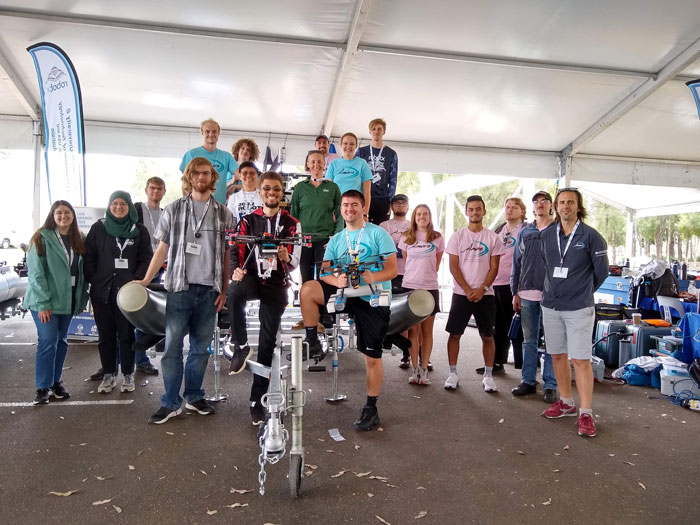In This Story
A team of six from George Mason University competed in the 2022 Maritime RobotX competition in Penrith, Australia, in November 2022. The travel team comprised three undergraduate students, Emina Sinanovic, Damion Colgrove, and Orion Colgrove; graduate student Vanessa Barth; Mason alumnus Reginald Lockhart, and Mechanical Engineering Department Chair Leigh McCue.
McCue has been aware of the Maritime RobotX competition, run by RoboNation, for about a decade.
“Being here at Mason with the Potomac Science Center and this amazing waterfront and doing more and more work in maritime robotics, it seemed like the right time and place [to compete],” she says.
The project began with a group of electrical and computer engineering; computer science; systems engineering and operations research; and mechanical engineering faculty writing a proposal for the boat upon which much of the competition is based. In all, twenty-six students across those four departments engaged in this maritime robotics opportunity, with technical advising provided by multiple faculty from each of those departments.
When the opportunity to attend the fall 2022 competition in Australia arose, the group faced challenges: global shipping issues made shipping the boat to Australia risky and expensive, and most of the students originally working on the project had graduated. Fortunately, Lockhart, now working locally for Bechtel, was still able to participate. The rest of the team, including twin senior mechanical engineering students Damion and Orion Colgrove, joined the project this year.
“My team had been tasked with developing a digital twin unmanned surface vehicle,” says Damion. “Through our work on this project, we ended up overlapping [with] many of the core elements of the competition, primarily the autonomous capabilities of the wave-adaptive modular vehicle (WAM-V). Additionally, Orion’s capstone team has been working on an autonomous drone for search and rescue missions, and this overlapped with many of the aerial aspects of the competition. Due to this connection, we were fortunate enough to be invited to participate in this event, and the resulting learning experience has been beyond valuable.”
“We made a tactical decision a couple months out not to ship the boat and to participate technically as a ‘documentation only’ team,” McCue explains. Mason’s team could have competed in only the elements for which they could bring equipment, but they chose to collaborate, joining a merged, multidisciplinary team from two other universities. McCue says, “RoboNation generously provided us on-site workspace, and we traveled with our UAV and sensing packages, joining a team of teams with Lake Superior State University and Queensland University of Technology.” Lockhart remarked on the collaborative nature of the event: “Teams that we weren't even necessarily teaming up with were sharing knowledge [and] parts,” he recalls, noting that one team even lent the Mason students use of a 3D printer. Ultimately, the merged team comprising students from Lake Superior State, Queensland, and Mason won an award for partnership and collaboration at the competition.

“Mason was able to tick off two competition tasks – the heartbeat message and UAV search and rescue,” McCue wrote in an email to colleagues after the event:
“It was exciting to see the onsite teamwork: as lead, Reggie [Lockhart] kept everyone on task, optimistic, and enthusiastic while rapidly tapping into resources from last year’s work; Emina [Sinanovic] and Vanessa [Barth] rallied to make the heartbeat happen; and, Orion and Damion [Colgrove] successfully executed UAV waypoint navigation and perception, all supported by the months of effort students and alums put into the project over the last year, plus wonderful camaraderie from all on-site teams, particularly our LSSU/QUT newfound friends.”
“We learned a lot over the course of this competition,” says Damion, adding, “Between events like this, as well as the senior capstone design program, … opportunities like this are some of the most valuable students can experience during their time in university.”
The team members expressed gratitude to all those who made this experience possible, and McCue looks forward to continuing Mason’s participation in RobotX at the next competition in 2024.
